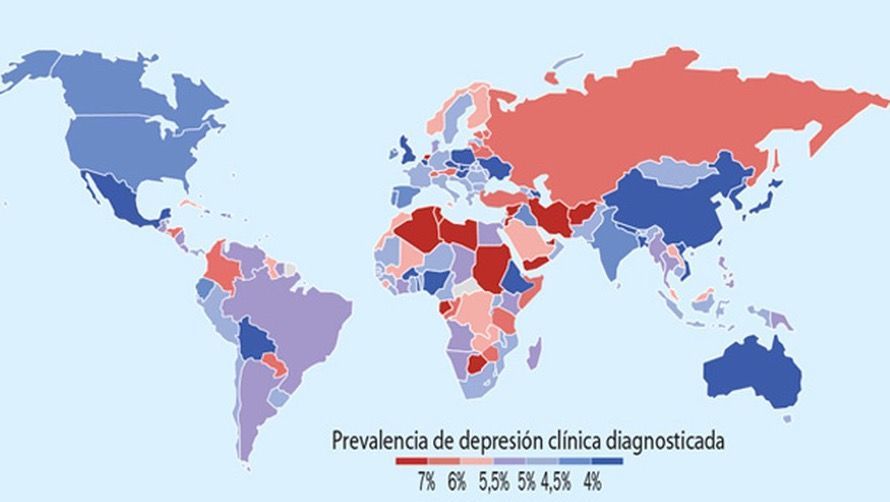Women are twice as likely to develop depression.
Jan 23, 2023
Women are twice as likely to develop depression.
Jan 23, 2023
According to the World Health Organization (WHO), there are socioeconomic or biological factors that increase women’s risk of suffering from this mental disorder.
Changes in sleep, decreased concentration, loss of appetite, feelings of hopelessness, guilt, or sadness are some symptoms of depression. Approximately 280 million people worldwide live with these symptoms, according to the WHO. However, according to the National Health Survey of Spain (ENSE), the figures by gender differ greatly, with women being twice as likely to suffer from this mental illness. This is reflected in the prevalence data of depression in women, which is double that of men at 7.1% versus 3.5%. In severe cases, this difference increases, with 3.5 women affected for every critical case in men. This inequality may be due to socioeconomic, biological, or cultural factors, among others.
Biological factors
As women progress through life, they encounter certain changes that increase the risk of developing depression. One of the first transformations they experience is puberty. The WHO points out that during this “key” stage, young women undergo hormonal changes, begin to question their sexuality, experience changes in their bodies, and face increased pressure to meet the expectations of the educational system. This transition from childhood to adolescence occurs “at an earlier age in girls,” increasing the chances of developing depression earlier.
Furthermore, as various gender studies note, during this stage many young women “begin to feel” symptoms of premenstrual syndrome (PMS) with “significant emotional consequences.” These symptoms “worsen” for nearly 10% of menstruating individuals who experience premenstrual dysphoric disorder (PMDD). Irritability, feelings of despair, suicidal thoughts, or a depressed mood are challenges faced by those affected and, according to mental health specialists, “these variables can eventually lead to depression.”
Pregnancy and/or the period leading up to conception are other critical stages. Experts in this field explain that trying to conceive and facing infertility or experiencing a miscarriage “causes high levels of frustration, misunderstanding, or fear.” If pregnancy is achieved, they face hormonal and bodily changes, concerns about the fetus’s future, and pressure to care for themselves and organize “every detail” to ensure the “best” welcome. This combination can “overwhelm women,” especially if combined with lack of family support, lifestyle changes, or an unwanted pregnancy.

It does not end there because, as several studies indicate, around 15% of women who become mothers end up suffering from postpartum depression. Psychologists specializing in this condition talk about feelings of guilt up to suicidal thoughts that may arise from hormonal changes, the “big life change and caregiving responsibility” involved, complications during childbirth, or doubts about “whether they are doing things right.” Later on comes menopause, during which estrogen levels “rise and fall uncontrollably,” sleep problems and a fast-paced life accelerate the onset of depression. Mental health professionals emphasize the need to highlight that having a history of anxiety, depression, or other disorders greatly increases the likelihood of suffering from it.
Living conditions
Everything goes beyond the biological, and the patriarchal system in which women live puts them in the spotlight. The United Nations (UN) Women’s department points out that one in three women suffers from gender-based violence. They also warn that if this type of abuse lasts over time, it can “severely affect the victim’s mental health and eventually annihilate her,” to the point of developing post-traumatic stress disorder (PTSD).
The gender pay gap causes women to “be at higher risk of poverty,” as Amnesty International describes. Psychologists explain that this leads to feelings of uncertainty about what might happen, negativity, or a sense of “lack of control.” A report published in the journal Science and prepared by Harvard University together with the Massachusetts Institute of Technology supports this idea, stating that people with lower incomes have up to three times greater chances of suffering from depression. Additionally, these economic circumstances hinder access to healthcare, and in some developing countries more than 75% of people affected by depression do not receive any treatment, according to the WHO.

At a cultural level, one only has to look back in time to remember that for centuries women were assigned the role of family caregivers. In most cases, they “neglected themselves” and felt a “great pressure if they did not meet the perfection expectations demanded by society.” Mental health professionals add that this can cause frustration, low self-esteem, guilt, and eventually lead to depressive states. The arrival of women into the workforce has meant they have to balance work with domestic responsibilities and “feel an overwhelming burden that is hard to bear.”
This constant activity fosters that “many women have high-functioning depression,” as clinical psychologist Carla Marie Manly classifies it. This type is more difficult to detect because life continues “normally,” with work, leisure, and caring for family members. Meanwhile, a study by the University of the Basque Country (UPV/EHU) states that “the consumption of prescribed psychotropic drugs is higher among women.”
Many cases remain silenced due to the existing “social stigma” around depression. Some women living with this condition report having heard that they are “hysterical” or that “it’s all an exaggeration.” The future is clear, and the Spanish Confederation of Mental Health notes that one in five women will develop depression during their lifetime. To stop this, the Ministry of Health is working on a Mental Health Action Plan until 2024 because it is a “problem that affects everyone.”
Useful links:
Adolescent Mental Health by the WHO. https://www.who.int/es/news-room/fact-sheets/detail/adolescent-mental-health
In Mujeres Magazine on health with a gender perspective, published by the Institute of Women. https://consaludmental.org/centro-documentacion/inmujeres-monografias-feministas-salud-genero/
European Health Survey in Spain, conducted by the Ministry of Health. https://www.sanidad.gob.es/estadEstudios/
According to the World Health Organization (WHO), there are socioeconomic or biological factors that increase women’s risk of suffering from this mental disorder.
Changes in sleep, decreased concentration, loss of appetite, feelings of hopelessness, guilt, or sadness are some symptoms of depression. Approximately 280 million people worldwide live with these symptoms, according to the WHO. However, according to the National Health Survey of Spain (ENSE), the figures by gender differ greatly, with women being twice as likely to suffer from this mental illness. This is reflected in the prevalence data of depression in women, which is double that of men at 7.1% versus 3.5%. In severe cases, this difference increases, with 3.5 women affected for every critical case in men. This inequality may be due to socioeconomic, biological, or cultural factors, among others.
Biological factors
As women progress through life, they encounter certain changes that increase the risk of developing depression. One of the first transformations they experience is puberty. The WHO points out that during this “key” stage, young women undergo hormonal changes, begin to question their sexuality, experience changes in their bodies, and face increased pressure to meet the expectations of the educational system. This transition from childhood to adolescence occurs “at an earlier age in girls,” increasing the chances of developing depression earlier.
Furthermore, as various gender studies note, during this stage many young women “begin to feel” symptoms of premenstrual syndrome (PMS) with “significant emotional consequences.” These symptoms “worsen” for nearly 10% of menstruating individuals who experience premenstrual dysphoric disorder (PMDD). Irritability, feelings of despair, suicidal thoughts, or a depressed mood are challenges faced by those affected and, according to mental health specialists, “these variables can eventually lead to depression.”
Pregnancy and/or the period leading up to conception are other critical stages. Experts in this field explain that trying to conceive and facing infertility or experiencing a miscarriage “causes high levels of frustration, misunderstanding, or fear.” If pregnancy is achieved, they face hormonal and bodily changes, concerns about the fetus’s future, and pressure to care for themselves and organize “every detail” to ensure the “best” welcome. This combination can “overwhelm women,” especially if combined with lack of family support, lifestyle changes, or an unwanted pregnancy.

It does not end there because, as several studies indicate, around 15% of women who become mothers end up suffering from postpartum depression. Psychologists specializing in this condition talk about feelings of guilt up to suicidal thoughts that may arise from hormonal changes, the “big life change and caregiving responsibility” involved, complications during childbirth, or doubts about “whether they are doing things right.” Later on comes menopause, during which estrogen levels “rise and fall uncontrollably,” sleep problems and a fast-paced life accelerate the onset of depression. Mental health professionals emphasize the need to highlight that having a history of anxiety, depression, or other disorders greatly increases the likelihood of suffering from it.
Living conditions
Everything goes beyond the biological, and the patriarchal system in which women live puts them in the spotlight. The United Nations (UN) Women’s department points out that one in three women suffers from gender-based violence. They also warn that if this type of abuse lasts over time, it can “severely affect the victim’s mental health and eventually annihilate her,” to the point of developing post-traumatic stress disorder (PTSD).
The gender pay gap causes women to “be at higher risk of poverty,” as Amnesty International describes. Psychologists explain that this leads to feelings of uncertainty about what might happen, negativity, or a sense of “lack of control.” A report published in the journal Science and prepared by Harvard University together with the Massachusetts Institute of Technology supports this idea, stating that people with lower incomes have up to three times greater chances of suffering from depression. Additionally, these economic circumstances hinder access to healthcare, and in some developing countries more than 75% of people affected by depression do not receive any treatment, according to the WHO.

At a cultural level, one only has to look back in time to remember that for centuries women were assigned the role of family caregivers. In most cases, they “neglected themselves” and felt a “great pressure if they did not meet the perfection expectations demanded by society.” Mental health professionals add that this can cause frustration, low self-esteem, guilt, and eventually lead to depressive states. The arrival of women into the workforce has meant they have to balance work with domestic responsibilities and “feel an overwhelming burden that is hard to bear.”
This constant activity fosters that “many women have high-functioning depression,” as clinical psychologist Carla Marie Manly classifies it. This type is more difficult to detect because life continues “normally,” with work, leisure, and caring for family members. Meanwhile, a study by the University of the Basque Country (UPV/EHU) states that “the consumption of prescribed psychotropic drugs is higher among women.”
Many cases remain silenced due to the existing “social stigma” around depression. Some women living with this condition report having heard that they are “hysterical” or that “it’s all an exaggeration.” The future is clear, and the Spanish Confederation of Mental Health notes that one in five women will develop depression during their lifetime. To stop this, the Ministry of Health is working on a Mental Health Action Plan until 2024 because it is a “problem that affects everyone.”
Useful links:
Adolescent Mental Health by the WHO. https://www.who.int/es/news-room/fact-sheets/detail/adolescent-mental-health
In Mujeres Magazine on health with a gender perspective, published by the Institute of Women. https://consaludmental.org/
centro-documentacion/inmujeres-monografias-feministas-salud-genero/
European Health Survey in Spain, conducted by the Ministry of Health. https://www.sanidad.

